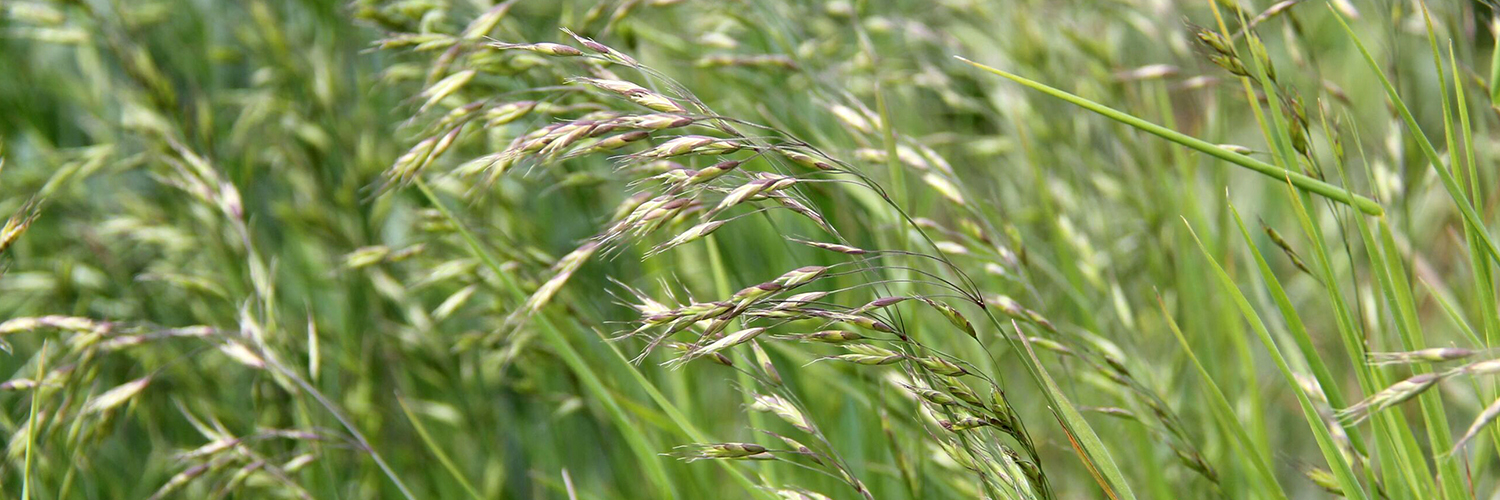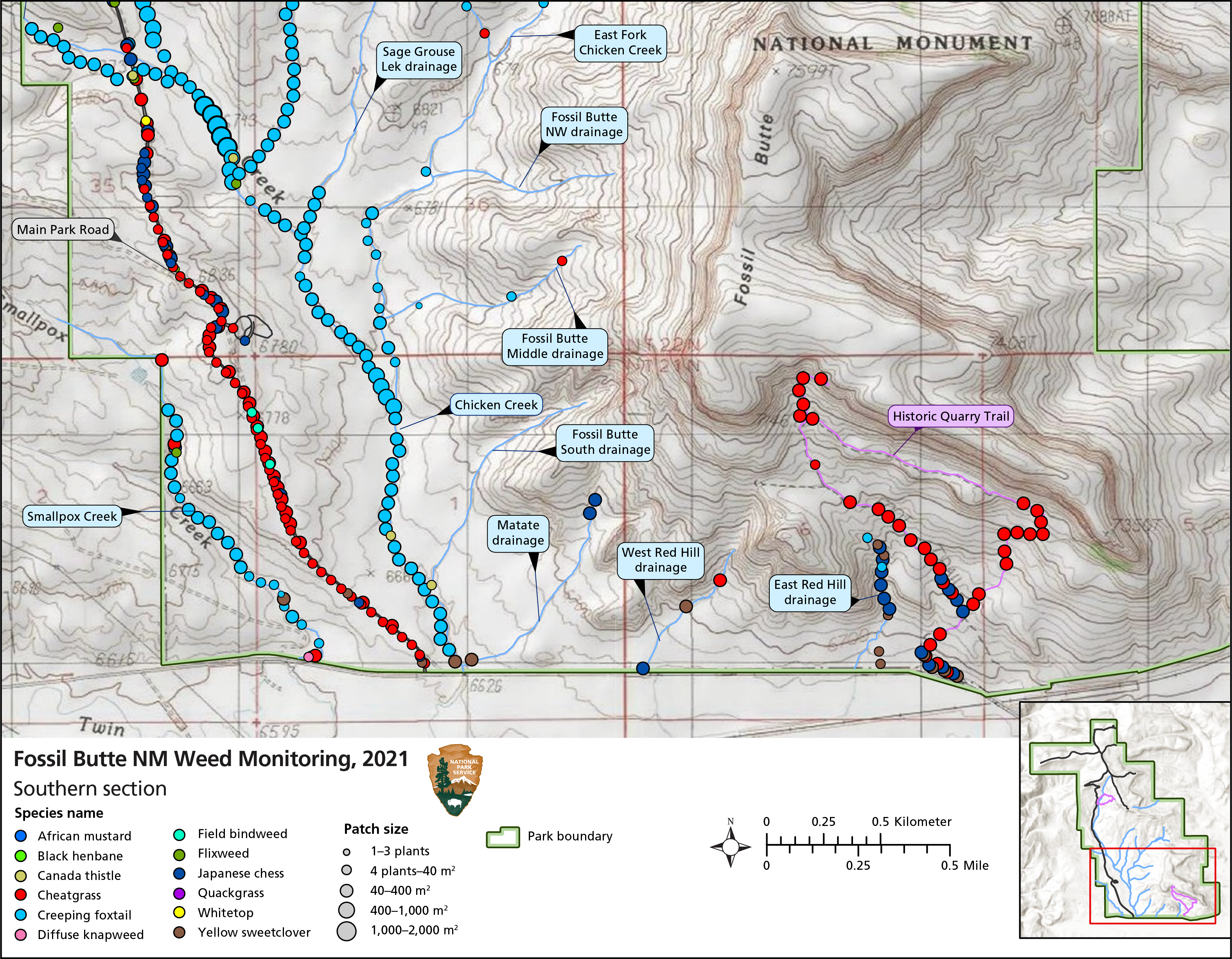Last updated: September 15, 2022
Article
Invasive Exotic Plant Monitoring at Fossil Butte National Monument

Japanese brome (Bromus japonicus). Sarah Schumacher, Bugwood.org
Invasive exotic plants are one of the most significant threats to natural resources in the national parks today. To provide early warning of weed invasions, the Northern Colorado Plateau Network (NCPN) monitors for these species in areas where they are likely to first establish: along roads, trails, and waterways.
What Are Invasive Exotic Plants?
Invasive exotic plants (IEPs) are species whose introduction to an environment “does or is likely to cause economic or environmental harm or harm to human health.” In national parks, IEPs can alter ecosystems at multiple scales—threatening wildlife, natural landscapes, and recreational opportunities.
IEPs are able to reproduce prolifically, rapidly colonize new areas, and displace native species. Invasive plants fill different ecological roles than the native plants they replace, leaving gaps in the system. In the absence of the native plants, the needs of species that depended on the native vegetation may go unmet, potentially creating a cascade of ecological effects.
The good news is that if discovered before they have a chance to take hold, IEP populations can be eradicated from parks. Small populations are cheaper and easier to control than large populations. Therefore, early detection is critical.
What Can Be Done?
To help park managers identify IEPs and prioritize control efforts, the Northern Colorado Plateau Network (NCPN) monitors invasive exotic plants in eight National Park Service units. First, network and park staff create a list of priority IEPs for each park. Then, on a rotating schedule, a field crew visually surveys for those IEPs along established monitoring routes. Along the routes, they stop and set up plots for additional data collection. The plot data allow network ecologists to estimate trends over time.
Recent Monitoring at Fossil Butte National Monument
During monitoring on June 26–29, 2021, a total of 763 patches of 12 different priority IEP species were detected along 61.9 kilometers (38.5 mi) of 22 monitoring routes at Fossil Butte National Monument (see table).
| Scientific name | Common name | Patches |
|---|---|---|
| Alopecurus arundinaceus | creeping foxtail | 229 |
| Bassia scoparia | summer cypress | 2 |
| Bromus japonicus | Japanese brome | 103 |
| Bromus tectorum | cheatgrass | 312 |
| Cardaria sp. | whitetop | 1 |
| Carduus nutans | musk thistle | 4 |
| Cirsium arvense | Canada thistle | 27 |
| Convolvulus arvensis | field bindweed | 3 |
| Descurainia sophia | flixweed | 36 |
| Elymus repens | quackgrass | 5 |
| Hyoscyamus niger | black henbane | 9 |
| Melilotus officinalis | yellow sweetclover | 32 |
| Total | – | 763 |
The highest densities of IEP patches were detected in several drainages and one trail: Sage Grouse Lek Drainage (32.7 patches/km), East Red Hill Drainage (19.4/km), Moose Bones Canyon (19.4/km), Main Park Road (19.0/km), West Fork Chicken Creek (17.6/km), Chicken Creek (15.0/km), Smallpox Creek (13.5/km), and the Historic Quarry Trail (11.1/km). The only routes free of priority IEPs in 2021 were Eagle Nest Point Road and the Fossil Butte Northwest, Wasatch Saddle, and North Dam Fork of Chicken Creek drainages.
Summer cypress (Bassia scoparia) was detected on monitoring routes for the first time, along the Main Park Road.
Cheatgrass (Bromus tectorum), creeping foxtail (Alopecurus arundinaceus), and Japanese brome (Bromus japonicus) were the most widespread IEPs. Creeping foxtail has continued to increase parkwide and along the Main Park Road and southern drainages. The two brome species have declined somewhat since 2018, but these species can fluctuate widely based on precipitation.
Flixweed (Descurainia sophia), whitetop (Cardaria sp.), and quackgrass (Elymus repens) all appear to have declined since 2018 and their previous highs in earlier years.

The dominance of cheatgrass and creeping foxtail can be seen across the southern section of the monument.
Possibilities for Management Control
Key findings
- Control efforts by park staff and the Northern Rockies Invasive Plant Management Team are likely helping to prevent some IEP increases in the park.
- Summer cypress was detected for the first time along the Main Park Road and should be a target for immediate control.
- Creeping foxtail continues to increase throughout the park.
- Areas away from riparian routes and the Main Park Road continued to have fewer IEPs.
Control efforts by park staff and the Northern Rockies Invasive Plant Management Team are likely helping to prevent some IEP increases in the park. Fifteen IEP species were treated in 2019–2020. In both years, work focused on roadsides, the Historic Quarry area, Millet Canyon, Chicken Creek Nature Trial, Murder Hill, and around the park visitor center and maintenance buildings. Declines in some treated species along the Main Park Road, particularly Canada thistle (Cirsium arvense), black henbane (Hyoscyamus niger), flixweed, and yellow sweetclover (Melilotus officinalis), were likely due to these treatments.
The intense efforts of controlling yellow sweetclover likely kept the increase in that population along the Main Park Road smaller than it otherwise would have been. Patches of Canada thistle and black henbane also saw small increases along the Main Park Road since 2018, but flixweed declined. The work on these species along the Historic Quarry Trail and Chicken Creek Nature Trail appears to have been successful.
Despite control efforts, patch density of cheatgrass remained high in 2021, although it declined somewhat from 2018. However, park managers should be congratulated for even being able to consider controlling cheatgrass, as its levels at many parks are too high for control efforts to be effective.
Summer cypress was detected for the first time along the Main Park Road and should be a target for immediate control.
Creeping foxtail continues to increase throughout the park, in the southern drainages, and along the Main Park Road. The increases in foxtail have driven an overall increase in priority IEPs in the southern drainages.
Additionally, in the central area of the park, the East and Northeast forks of Chicken Creek, Fossil Butte Middle drainage, and Cundick Ridge Road had low patch densities in 2021. However, patches in the Sage Grouse Lek Drainage, in this same area, increased dramatically from 2018, all due to creeping foxtail. These areas should be priority locations for future control efforts of creeping foxtail.
Areas away from riparian routes and the Main Park Road continued to have fewer IEPs. In 2021, the Wasatch Saddle drainage, North Dam Fork of Chicken Creek, and Fossil Butte Northwest drainage were free of priority weed species. Efforts should be made to eliminate patches in nearby drainages and trails, to prevent increases in these areas.
Network staff plan to return to Fossil Butte NM for an eighth round of monitoring in 2023.
Past Findings
Invasive Exotic Plant Monitoring at Fossil Butte National Monument, 2018
Information in this article was summarized from DW Perkins, Invasive Exotic Plant Monitoring in Fossil Butte National Monument: 2021 Field Season.
